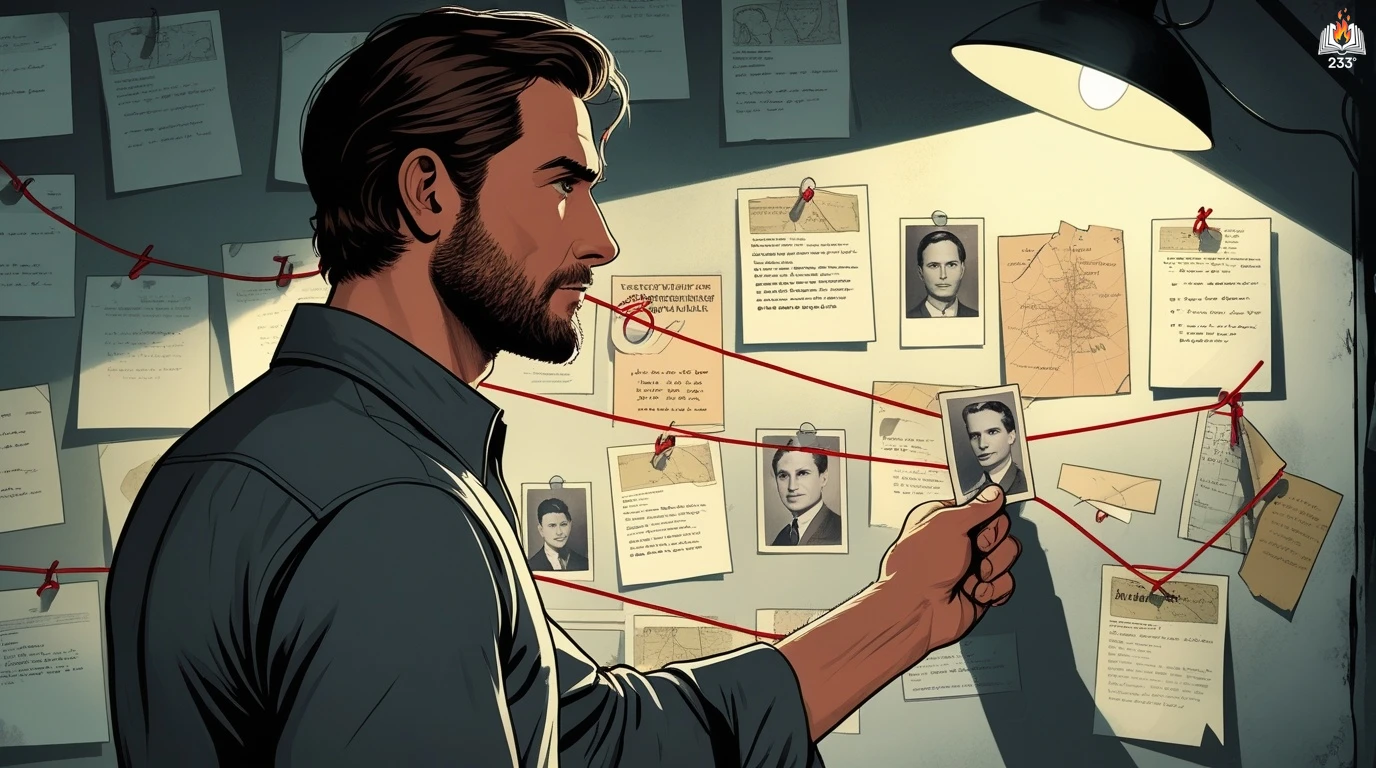Five Little Pigs by Agatha Christie, published in 1942, is one of her most psychologically intricate Hercule Poirot mysteries. It revisits a murder from sixteen years earlier, blending past and present as Poirot reexamines the conviction of Caroline Crale for poisoning her husband, the celebrated painter Amyas Crale. The novel is part of the famed Hercule Poirot series and plays with the structure of multiple viewpoints, drawing inspiration from the nursery rhyme that gives it its title.
Plot Summary
Sixteen years had passed since Caroline Crale was convicted of poisoning her husband, Amyas Crale, the brilliant and tempestuous painter whose passion for life was matched only by his selfishness. Caroline had gone to her grave under the shadow of guilt, leaving behind a young daughter, Carla, who was sent to Canada and given a new name. But when Carla turned twenty-one, a letter written by her mother on the eve of her death reached her hands. In it, Caroline claimed her innocence, pleading for her daughter to believe in her, even as the world had condemned her. With the weight of this truth, Carla crossed the Atlantic to seek out the only man she believed could untangle the past – Hercule Poirot.
Poirot, intrigued by the challenge of solving a murder long cold, agreed to help. The case was peculiar: the physical clues had long vanished, but the people, their memories, and their motives remained. Poirot decided to reexamine the five who had been closest to the crime, each a figure in a pattern that echoed the nursery rhyme of five little pigs. He sought not the evidence of things, but the evidence of minds and hearts.
Philip Blake was the first. A robust, confident man with the easy laughter of one used to success, Philip had been Amyas’s closest friend. Yet beneath his jovial manner, Poirot sensed a lingering bitterness. Philip had loved Caroline in his own silent, thwarted way, and her choice of Amyas had left a scar he carried still. He remembered the past vividly: Caroline’s jealous rages, Amyas’s infidelity, Elsa Greer’s brazen intrusion into their lives. To Philip, Caroline was guilty beyond question, a woman driven to murder by humiliation and despair.
Meredith Blake, Philip’s elder brother, was a gentler soul, a man devoted to his herbs and chemicals, uneasy in the world of passions. It was Meredith’s bottle of coniine, a deadly poison, that had vanished from his study in the days before the murder. Meredith had invited the Crales and their guests to tea, showing off his potions and preparations. The theft of the poison haunted him still, his guilt mingling with confusion. He spoke of Caroline with a kind of sad respect, but like Philip, he believed her capable of the deed. His memories were tinged with the ache of a man who had watched disaster unfold, powerless to stop it.
Poirot then turned to Elsa Greer, now Lady Dittisham, a figure of wealth and society. As a young woman, Elsa had been Amyas’s muse, her beauty and youth igniting a fire in him that he had been determined to follow, no matter the cost. Elsa had believed in her triumph – that Amyas would leave Caroline and marry her. But death had intervened. Elsa was cool, polished, and unrepentant, still dismissive of Caroline’s claim on Amyas. To her, Caroline had been the bitter, aging wife clinging to a man she had already lost. The past, Elsa suggested with a careless shrug, was simple: Caroline had killed her husband to stop him from leaving.
Cecilia Williams, the governess, offered a sharper, more moral voice. Plain, severe, but deeply principled, Cecilia had been devoted to Caroline and Angela Warren, Caroline’s much younger half-sister. She remembered Caroline’s suffering, the tension in the household, the quiet endurance that masked a breaking heart. Cecilia had seen Caroline’s grief and rage, but she had also seen her courage. Unlike the others, Cecilia left room for doubt, sensing that there were undercurrents never fully revealed.
Angela Warren, now an explorer and scholar, had once been a mischievous teenager, lively and bold. She bore on her face the scar of an old accident, a paperweight hurled in a childhood quarrel by Caroline, an incident that had been used to paint Caroline as a woman of violent temper. But Angela loved her sister fiercely, even now. She recalled that summer with vivid clarity – Amyas’s careless charm, Elsa’s taunting presence, Caroline’s mounting desperation. Angela alone confessed to moments of confusion, to doubts she had carried for years.
Poirot, weaving these threads together, saw the shape of something that had eluded the law. He gathered them all, the five little pigs, and asked each to recount their memories once more. As they spoke, the pieces settled into place. Amyas Crale had been working feverishly on Elsa’s portrait, intent on finishing before taking the next step in his life. He had promised Elsa marriage, yet his heart belonged to his art. Elsa, impatient, had pressed him, but Amyas had been cool, almost dismissive, speaking only of his painting.
Caroline had discovered Amyas’s intentions and confronted him. There had been fierce words, threats overheard by the others. Yet on the day of the murder, Caroline had brought him a glass of beer, smiled, and walked away. Amyas had drunk it without hesitation, later complaining that everything tasted foul. Hours later, he was dead.
The case against Caroline had been built on the disappearance of the poison, the presence of her fingerprints, and the assumption that no one else had motive or opportunity. But Poirot saw the flaw. Caroline had intended to take the poison herself. She had stolen it, hidden it, planned a lonely death. But the poison ended up in Amyas’s glass, and only one person had the means, the presence, and the bitter heart to do it.
Elsa had waited, watched, and understood. She had realized, with a sudden shock, that Amyas was never going to leave his wife, that his promises were the idle words of a man absorbed in his art. The humiliation, the rage, the unbearable knowledge that she was just another muse, another passing inspiration – these had driven her to act. In a quiet moment, while Caroline was occupied, Elsa had poured the poison into Amyas’s beer. She had watched him drink, seen the change in him, and had walked away with her head high, her triumph turned to ash.
Caroline, discovering the crime, had seen at once what had happened. But she had chosen silence. To spare Elsa? To shield Amyas’s name from scandal? Or perhaps because, in the end, she no longer cared? She had taken the blame with the same quiet determination that had marked her life, leaving only the truth in a letter for her daughter.
When Poirot revealed the truth, the five little pigs stood silent, each face turned toward the past they had shaped, the past they had survived. Justice, long delayed, moved gently at last, not with the fury of the courtroom, but with the slow and painful turning of hearts.
Main Characters
Hercule Poirot: The meticulous Belgian detective with a flair for precision and deduction, Poirot is approached by Carla Lemarchant to clear her late mother’s name. His method relies on understanding human nature, and in this case, reconstructing memories to untangle the truth from five conflicting testimonies.
Carla Lemarchant: The determined daughter of Caroline and Amyas Crale, Carla is in her early twenties when she asks Poirot to investigate. Her driving motivation is to uncover the truth and restore her mother’s honor, showing courage and persistence throughout.
Caroline Crale: A passionate and tragic figure, Caroline was convicted of killing her husband and died in prison. Through the eyes of others, she emerges as a complex woman – devoted, tormented, and perhaps resigned, with her stoicism concealing deep emotions.
Amyas Crale: A famous painter and the murder victim, Amyas is portrayed as a man of immense talent and magnetism but also selfishness and cruelty in his personal life. His relationships and his artistic obsession are central to the drama that unfolds.
Philip Blake: A wealthy, jovial stockbroker and Amyas’s closest friend, Philip harbors hidden feelings for Caroline. His bitterness and repressed emotions surface in subtle but crucial ways during Poirot’s investigation.
Meredith Blake: Philip’s older brother, a mild and nervous man with an interest in chemistry and herbs. Meredith’s guilt and uncertainty about the past lend depth to his hesitant personality.
Elsa Greer (Lady Dittisham): Once Amyas’s young, bold muse and lover, Elsa has since become a socialite. Her unapologetic ambition and beauty made her a disruptive force in the Crale household and a key figure in the murder mystery.
Cecilia Williams: The strict and principled governess, she represents moral clarity and authority, yet her stern demeanor hides quiet care and loyalty, particularly toward young Carla and Angela.
Angela Warren: Caroline’s half-sister, a sharp and independent woman with a scarred face from childhood, Angela was a rebellious teen during the murder and has grown into a strong-willed adventurer.
Theme
Memory and Subjectivity: The novel explores how memory can be fragmented, biased, or reshaped over time. Each character’s recollection is colored by emotion, guilt, or denial, highlighting the unreliability of witness testimony.
Justice and Truth: Agatha Christie raises questions about the nature of justice: is legal guilt the same as moral guilt? Poirot’s investigation becomes a quest for a deeper, more human truth, beyond what the courts decided.
Love and Betrayal: The tangled web of relationships — marital loyalty, illicit passion, unrequited love, and sibling bonds — drives the characters’ motives. Christie shows how love can inspire devotion but also jealousy, cruelty, and betrayal.
Art and Obsession: Amyas’s artistic genius and obsession serve as both a source of inspiration and destruction. Christie reflects on the cost of genius, especially when it overrides empathy and responsibility.
Writing Style and Tone
Agatha Christie’s writing in Five Little Pigs is measured, economical, and deceptively simple, with an elegant precision that mirrors Poirot’s own meticulous reasoning. Her narrative weaves together past and present seamlessly, using clear, crisp dialogue and subtle psychological insight to build her characters. The structure, built around the nursery rhyme, provides both a playful motif and a chilling framework for examining the crime.
The tone of the novel is reflective, melancholic, and at times deeply poignant. While Christie’s mysteries often maintain a lightness, here she infuses the story with a darker emotional current, exploring themes of regret, missed chances, and the weight of the past. The final revelation is delivered not just as a clever twist, but as a moment of profound human reckoning, adding emotional weight to the intellectual puzzle.
We hope this summary has sparked your interest and would appreciate you following Celsius 233 on social media:
There’s a treasure trove of other fascinating book summaries waiting for you. Check out our collection of stories that inspire, thrill, and provoke thought, just like this one by checking out the Book Shelf or the Library
Remember, while our summaries capture the essence, they can never replace the full experience of reading the book. If this summary intrigued you, consider diving into the complete story – buy the book and immerse yourself in the author’s original work.
If you want to request a book summary, click here.
When Saurabh is not working/watching football/reading books/traveling, you can reach him via Twitter/X, LinkedIn, or Threads
Restart reading!








